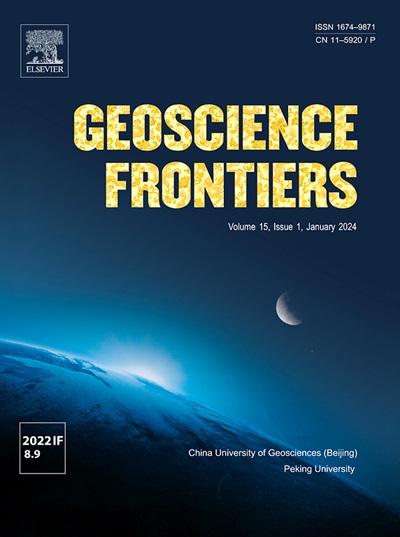Evaluation of environmental geochemical signatures due to RO rejects on arid agricultural farms and tangible solutions
IF 8.5
1区 地球科学
Q1 GEOSCIENCES, MULTIDISCIPLINARY
引用次数: 0
Abstract
The impact of reverse osmosis (RO) rejects in the groundwater presents a significant challenge in arid regions. This study collected groundwater samples, product water, and reverse osmosis brine (ROB) from evaporation ponds and analyzed them for major ions and trace elements. Test boreholes were drilled near the ROB site along the flow direction, and borehole sediment samples were collected. The samples were predominantly gravelly sand, and the depth to water level fluctuated around 30 m below ground level (bgl), with minerals mainly consisting of calcite, gypsum, and Quartz. Data loggers reflected a rise in water level (<22 m bgl) corresponding to higher electrical conductivity (>16 mS/Cm) during the cropping period in many locations, confirming the impact of ROB in groundwater. The results were further supported by enriched signatures of δ18O (∼ +1.5‰) and δ2H (∼ +15‰). The saturation index of the minerals reflected that carbonate minerals (Calcite > Dolomite) were saturated in the ROB relative to the groundwater. The vertical variation of mineral assemblages in the boreholes indicated gypsum precipitation in the capillary zone along with calcite and dolomite. The assemblage varies as the groundwater moves from the disposal site. The speciation of different compounds along the groundwater path indicated higher carbonate and sulfate species (CaCO3 > CaHCO3> CaSO4 > NaSO4 > MgSO4) near the disposal site, with variations along the flow direction. Considering the significant variation in temperature in the region (5 to 50 ℃), the water sample composition was modeled using PHREEQC, suggesting that the increase in temperature led to supersaturation of Epsomite and Gypsum compositions. The ROB was theoretically mixed with groundwater and product water in different proportions, and an optimum composition (10:90) for safe disposal was derived and tested fit for reuse in agriculture.

对干旱农田反渗透废渣造成的环境地球化学特征的评估和切实可行的解决方案
反渗透(RO)废水对地下水的影响是干旱地区面临的一项重大挑战。这项研究从蒸发池收集了地下水样本、产品水和反渗透盐水(ROB),并对其进行了主要离子和微量元素分析。在反渗透盐水站点附近沿水流方向钻了测试钻孔,并采集了钻孔沉积物样本。样本主要为砾质砂,水位深度在地面以下 30 米左右波动,矿物主要包括方解石、石膏和石英。数据记录器显示,在许多地点,水位上升(22 m bgl)与较高的电导率(16 mS/Cm)相对应,证实了地下水中 ROB 的影响。δ18O(∼ +1.5‰)和δ2H(∼ +15‰)的富集特征进一步证实了这一结果。矿物饱和度指数反映了相对于地下水而言,ROB 中的碳酸盐矿物(方解石和白云石)处于饱和状态。钻孔中矿物组合的垂直变化表明,石膏与方解石和白云石一起沉淀在毛细管区。随着地下水从弃置地点流出,矿物组合也随之变化。地下水流经路径上不同化合物的标示表明,弃置场附近的碳酸盐和硫酸盐种类(CaCO3 > CaHCO3> CaSO4 > NaSO4 > MgSO4)较多,并随水流方向而变化。考虑到该区域的温度变化很大(5 至 50 ℃),使用 PHREEQC 对水样成分进行了模拟,结果表明温度的升高导致了泻盐和石膏成分的过饱和。从理论上讲,ROB 与地下水和产品水以不同比例混合,得出了安全处置的最佳成分(10:90),并测试了是否适合在农业中重复使用。
本文章由计算机程序翻译,如有差异,请以英文原文为准。
求助全文
约1分钟内获得全文
求助全文
来源期刊

Geoscience frontiers
Earth and Planetary Sciences-General Earth and Planetary Sciences
CiteScore
17.80
自引率
3.40%
发文量
147
审稿时长
35 days
期刊介绍:
Geoscience Frontiers (GSF) is the Journal of China University of Geosciences (Beijing) and Peking University. It publishes peer-reviewed research articles and reviews in interdisciplinary fields of Earth and Planetary Sciences. GSF covers various research areas including petrology and geochemistry, lithospheric architecture and mantle dynamics, global tectonics, economic geology and fuel exploration, geophysics, stratigraphy and paleontology, environmental and engineering geology, astrogeology, and the nexus of resources-energy-emissions-climate under Sustainable Development Goals. The journal aims to bridge innovative, provocative, and challenging concepts and models in these fields, providing insights on correlations and evolution.
 求助内容:
求助内容: 应助结果提醒方式:
应助结果提醒方式:


